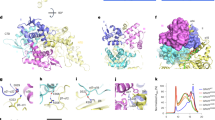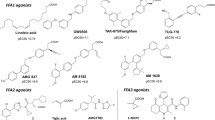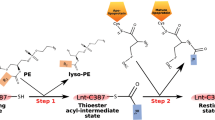Abstract
Liver fatty acid binding protein (LFABP) is unique among the various types of FABPs in that it can bind a variety of ligands in addition to fatty acids. LFABP is able to bind long chain fatty acids with a 2:1 stoichiometry and the crystal structure has identified two fatty acid binding sites in the binding cavity. The presumed primary site (site 1) involves the fatty acid binding with the carboxylate group buried in the cavity whereas the fatty acid at site 2 has the carboxylate group solvent-exposed within the ligand portal region and in the vicinity of α-helix II. The α-helical region contains three cationic residues, K20, K31, K33 and modelling studies suggest that K31 on α-helix II could make an electrostatic contribution to anionic ligands binding to site 2. The preparation of three charge reversal mutants of LFABP, K20E, K31E and K33E has allowed an investigation of the role of site 2 in ligand binding, particularly those ligands with a bulky anionic head group. The binding of oleoyl CoA, lysophosphatidic acid, lysophosphatidylcholine, lithocholic acid and taurolithocholate 3-sulphate to LFABP has been studied using the α-helical mutants. The results support the concept that such ligands bind at site 2 of LFABP where solvent exposure allows the accommodation of their bulky anionic group.
Similar content being viewed by others
References
Thompson J, Winter N, Terwey D, Bratt J, Banaszak L: The crystal structure of the liver fatty acid-binding protein - A complex with two bound oleates. J Biol Chem 272: 7140–7150, 1997
Thompson J, Ory J, ReeseWagoner A, Banaszak L: The liver fatty acid binding protein - comparison of cavity properties of intracellular lipid binding proteins. Mol Cell Biochem 192: 9–16, 1999
Thompson J, Reese-Wagoner A, Banaszak L: Liver fatty acid binding protein: Species variation and the accommodation of different ligands. Biochim Biophys Acta Mol Cell Biol Lipids 1441: 117–130, 1999
Davies JK, Thumser AA, Wilton DC: Binding of recombinant rat liver fatty acid-binding protein to small anionic phospholipid vesicles results in ligand release: A model for interfacial binding and fatty acid targeting. Biochemistry 38: 16932–16940, 1999
Davies JK, Wilton DC: Effect of charge reversal mutations within the α-helical region of liver fatty acid binding protein on the ligand and membrane binding properties of the protein. (submitted)
Wilkinson TI, Wilton DC: Studies on fatty acid-binding proteins - the binding-properties of rat-liver fatty acid-binding protein. Biochem J 247: 485–488, 1987
Worrall AF, Evans C, Wilton DC: Synthesis of a gene for rat-liver fattyacid-binding protein and its expression in Escherichia-coli. Biochem J 278: 365–368, 1991
Kane CD, Bernlohr DA: A simple assay for intracellular lipid-binding proteins using displacement of 1-anilinonaphthalene 8-sulfonic acid. Anal Biochem 233: 197–204, 1996
Hubbell T, Behnke WD, Woodford JK, Schroeder F: Recombinant liver fatty-acid-binding protein interacts with fatty acyl-coenzyme-A. Biochemistry 33: 3327–3334, 1994
Rolf B, OudenampsenKruger E, Borchers T, Faergeman NJ, Knudsen J, Lezius A, Spener F: Analysis of the ligand binding properties of recombinant bovine liver-type fatty acid binding protein. Biochim Biophys Acta Lipids Lipid Metab 1259: 245–253, 1995
Knudsen J, Jensen MV, Hansen JK, Faergeman NJ, Neergaard TF, Gaigg B: Role of acylCoA binding protein in acylCoA transport, metabolism and cell signaling. Mol Cell Biochem 192: 95–103, 1999
Thumser AA, Voysey JE, Wilton DC: The binding of lysophospholipids to rat-liver fatty-acid-binding protein and albumin. Biochem J 301: 801–806, 1994
Thumser AA, Wilton DC: The binding of cholesterol and bile salts to recombinant rat liver fatty acid-binding protein. Biochem J 320: 729–733, 1996
Dietrich A, Dieminger W, Fuchte K, Stoll GH, Schlitz E, Gerok W, Kurz G: Functional-significance of interaction of h-fabp with sulfated and nonsulfated taurine-conjugated bile-salts in rat-liver. J Lipid Res 36: 1745–1755, 1995
Lucke C, Zhang FL, Hamilton JA, Sacchettini JC, Ruterjans H: Solution structure of ileal lipid binding protein in complex with glycocholate. Eur J Biochem 267: 2929–2938, 2000
Thompson J, Ory J, ReeseWagoner A, Banaszak L: The liver fatty acid binding protein - comparison of cavity properties of intracellular lipid binding proteins. Mol Cell Biochem 192: 9–16, 1999
Stewart JM, Slysz GW, Pritting MA, Mullereberhard U: Ferriheme and ferroheme are isosteric inhibitors of fatty acid binding to rat liver fatty acid binding protein. Biochem Cell Biol Biochim Biol Cell 74: 249–255, 1996
Lalonde JM, Bernlohr DA, Banaszak LJ: X-ray crystallographic structures of adipocyte lipid-binding protein complexed with palmitate and hexadecanesulfonic acid - properties of cavity binding-sites. Biochemistry 33: 4885–4895, 1994
Author information
Authors and Affiliations
Rights and permissions
About this article
Cite this article
Hagan, R., Davies, J.K. & Wilton, D.C. The effect of charge reversal mutations in the α-helical region of liver fatty acid binding protein on the binding of fatty-acyl CoAs, lysophospholipids and bile acids. Mol Cell Biochem 239, 55–60 (2002). https://doi.org/10.1023/A:1020562808304
Issue Date:
DOI: https://doi.org/10.1023/A:1020562808304




